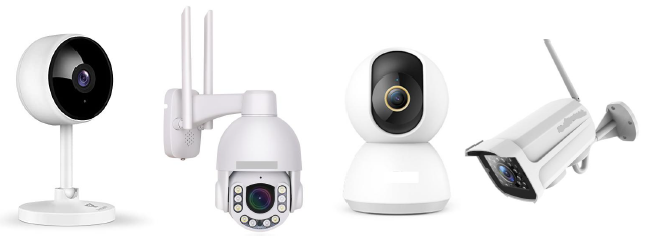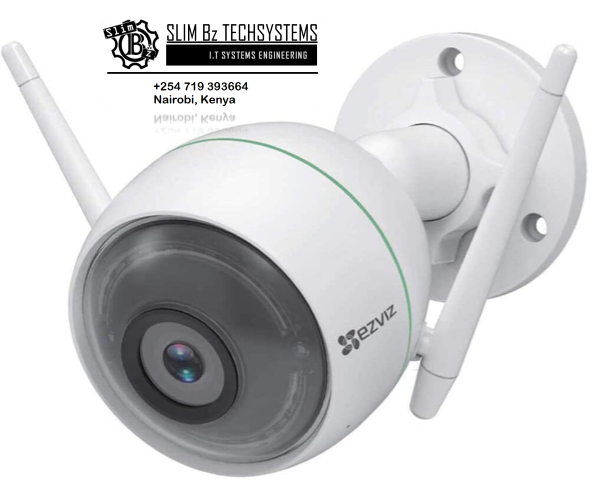STAND ALONE CCTV SECURITY CAMERAS – BUYERS’ GUIDE
- Boney Maundu

- Sep 3, 2023
- 6 min read
Updated: Oct 11, 2023

A basic buyer’s guide for stand-alone Security Cameras
When it comes to CCTV Security & Surveillance Cameras, there’s a plethora of options to choose from and to the regular person, the sheer amount of information available on security cameras can be overwhelming which often leads to analysis paralysis.
To simplify, the type of camera system to acquire depends on a whole lot of factors which are vast and varied, ranging from environmental to budgetary concerns.
Stand-alone security cameras are one option to consider for the regular shop, small business, and homeowner or renter looking for a cheap but reliable alternative to a fully-fledged or integrated CCTV system.
Stand-alone cameras function as an autonomous entity without the need for a centralized recorder i.e. all the capturing, processing, data storage, and attendant functions as alerts happen at the camera level as opposed to an integrated system where storage, alerts, and a variety of other functions are controlled and/ or determined by the centralized recorder i.e. NVR or DVR.
In most cases, the choice of stand-alone cameras is usually down to cost.
They do not need an expensive centralized system like a DVR, XVR, or NVR to connect to, thereby bringing down the cost
Wi-Fi-capable cameras eliminate the need for cables as long as they can connect to a decent / readily available Wi-Fi connection
Due to the above reasons, a DIY install by the owner can be attempted, with mixed results depending on the technical skills of the owner. This would eliminate the need to hire a professional to install the system, which could be costly, depending on the complexity and scope of the whole project.
CONNECTIVITY
As the name suggests, stand-alone cameras are autonomous, i.e. they do not need to connect to a central recording or storage device to get power, data connection or to transmit video footage. All the processing happens at the camera level
Power
Usually, CCTV cameras are powered using power cables (AC – 240v & DC – 12v/24v), a USB cable (for 5v models), or an Ethernet cable (for POE-capable models).
Different stand-alone camera models support varied power modes. Most indoor models use USB connections or an in-built battery. Most outdoor models, apart from 12v or POE also have the option of in-built batteries or solar power through attached solar panels which typically charge the in-built batteries during the day
When proximity to power outlets is an issue, cameras powered by in-built batteries come in handy. This gives them the flexibility to be mounted on walls, ceilings, and in an outdoor situation, on a post, pillar, or even tree without the hassle of having to route a cable towards a power source, which in some cases can be inconveniencing or downright impossible.
Wi-Fi and Internet
Depending on the type of camera, some have Wi-Fi capabilities, while others have to be hard-wired to an internet connection like a router or a network switch, though most have both options.
Especially for models that support Wi-Fi connectivity, the owner can do a DIY install – with varied results depending on their technical skills.
As with power, the ability to connect to the internet over Wi-Fi eliminates the need of having to route an Ethernet cable to the router.
Indoors, Ethernet cables can be hideous and inconvenient when snaking around the house from where the camera is located to the router. Power outlets, on the other hand, are easier to connect to as they’re almost everywhere in the house.
In the case of an outdoor installation, as long as there’s sufficient Wi-Fi presence outside, preferably via a Wi-Fi access point, battery-powered cameras would work.
In case of weak or zero presence of Wi-Fi outside, 4G capable stand-alone cameras exist. These only need a SIM card with data and they’re good to go. This could be especially handy for remote areas and outposts or sites where there’s neither power nor Wi-Fi.
In cases where there is no option for internet or 4G connection, some models allow you to just power them and have them record all activities in their scope which can be reviewed later.
STORAGE
For someone seeking a light solution e.g. to monitor babies, the front door, or a small shop/ office, getting a whole dedicated recorder just to plug in one or two cameras seems over the top. Hence the need for a stand-alone solution.
All the footage that’s captured is recorded on a micro SD card located inside the camera. Micro-SD cards are cheap and readily available as opposed to a hard drive that’s more than ten times the cost of a micro-SD card and would probably require a professional to install.
Depending on the camera model, they accept SD cards with a large enough capacity to perfectly suit the needs of a regular user. Footage can last for up to 2 weeks depending on the size of the storage medium and settings like motion recording and scene complexity.
ALERTS AND NOTIFICATIONS
Some stand-alone cameras support a variety of other features e.g.
Push notifications: These are notifications that are sent to the users’ mobile devices that notify them of events detected by the camera which can include motion detection, audio or sound detection, power or internet connectivity status, etc.
In the case of motion detection, the camera can notify the user if the camera detects movement in its scope.
Additional features like triggering a siren and flashing lights can also be programmed in case motion is detected – depending on the model.
Notifications can come in the form of texts (for models with SIM cards installed), emails, or notifications on the viewing app.
Those that have a PTZ (Pan-Tilt-Zoom) feature can be programmed to track and zoom in on detected movement.
BANDWIDTH
As opposed to cameras that connect to a centralized recorder which have to transmit data to the recorder for processing and storage, stand-alone cameras do all the processing at the camera level. This therefore reduces the bandwidth burden on the user’s network. They only consume considerable bandwidth when being accessed via mobile device or when sending push notifications to a user’s mobile device.
LIMITATIONS AND PITFALLS
Power
For battery-powered models, the type of battery installed in the device matters. Low quality batteries might keep the cost of the camera lower which is a major reason for acquiring stand-alone cameras in the first place. The downside is having to replace batteries often, failure to which the camera will obviously go off. Depending on where it was installed, this can become an irritating inconvenience.
Solar-powered models can counter the above issue, though this depends on the amount of sunshine available for them to fully charge the batteries. This means they can only be installed outside. It’s important to also note that as much as solar panels charge the batteries, over time, batteries lose the capacity to hold charge and would have to be replaced eventually.
Connectivity
For wireless stand-alone cameras, installation is a breeze as you only need to find a power source or none at all if they’re battery-powered. However since they have to connect to a reliable network, proximity to a Wi-Fi router or access point is critical.
Installing cameras where there is a weak Wi-Fi signal would result in the camera buffering when the user tries to access it remotely and when the connection is downright bad, the camera would go offline, a frustrating experience.
For wireless cameras, going offline even when powered means nothing can be seen or recorded. So having stand-alone cameras in areas where the Wi-Fi signal is weak is pointless unless an access point is installed to bolster the signal strength which would most definitely increase the cost of the whole setup.
In the case of 4G capable cameras, the user has to ensure the SIM card always has data bundles otherwise it’s the same issue as the weak or non-existent Wi-Fi. Integrated cameras on the other hand do not need the internet to work as they record and store their data to a centralized recorder, transmitting via direct cable.
Storage
Stand-alone cameras typically record on micro SD cards located/ installed inside the camera. This poses a security risk. In case of an event, an unauthorized person can easily access the storage card by just popping it out and leaving with all the evidence. Or in the worst-case scenario, they could just cart away the whole camera which is no trouble at all.
With an integrated CCTV system, on the other hand, all footage is stored on the recorder which is hopefully in a secure hard-to-access place inside the premises. Tampering with the individual camera would just mean the camera would stop recording at that precise moment but all footage prior to the event would have been stored safely in the recorder.
As with any technological device, there are pitfalls and limitations that can be tolerable or intolerable depending on the individual user’s situation. By looking at the merits of what a device can offer versus its attendant limitations, a user can make an informed decision on whether they can lie with the limitations if they’re not as dire as to render the system impractical for their purposes
More Information
Stand-alone security cameras vs Integrated CCTV System: A comparative analysis
CCTV Security Systems: Buyer's guide for business owners
Tech Contractor / Writer
Nairobi, Kenya


















The Locksmith Gastonia NC company did an exceptional job installing our CCTV security cameras. Their attention to detail and expertise ensured every angle of our property is now under surveillance, providing us with peace of mind.